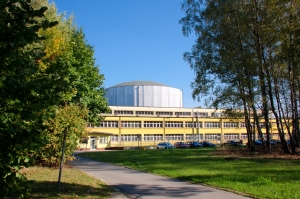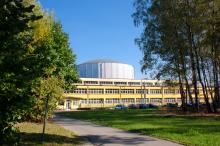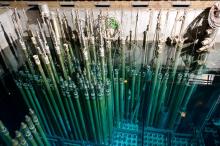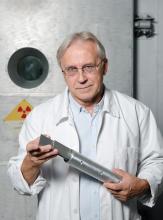Molibdenum-99 isotope widely applied in nuclear medicine to save human life is produced from uranium targets irradiated in research nuclear reactors. The NCBJ-operated MARIA reactor is covering nearly 20% of world demand for the targets. MARIA has already helped more than 75.5 million patients.
Just a few research nuclear reactors in the world are routinely irradiating uranium targets, from which later molibdenum-99, an isotope used as the base of many radiopharmaceuticals applied in nuclear medicine, is produced. Combined output of all those reactors is sufficient to perform annually about 25 million cancer treatment diagnostic/therapeutic procedures (of which about 215 thousand are performed in Poland). Effective diagnostic procedures are a key factor in fighting cancer – the sooner cancer changes are detected, the more probable is that the patient will be successfully cured. Nuclear medicine methods are indispensable among such procedures. World Health Organisation predicts that the number of cancer cases globally detected in humans will double before 2020. It means that the demand for molibdenum-99 is probably going to steadily rise.
It follows that continuity and security of supply of molibdenum-99 is a pretty crucial issue. Because of a relatively short lifetime of the isotope, it is relatively quickly becoming less and less useful in medical diagnostic/treatment procedures, so radiopharmaceuticals based on it cannot be produced in advance and stored waiting for future demand – they must be regularly delivered to nuclear medicine clinics. Discontinuity of supplies from just one of the few reactors in the world routinely irradiating the uranium targets may result in putting security of deliveries of molibdenum-99 in jeopardy. Such cases already happened in 2007, 2008, 2010 and at the turn of 2013/2014. World deficit of molibdenum-99 observed at those times has prompted governments and nuclear medicine experts to establish cooperation in that matter under an UN aegis.
„All that shows that global demand for molibdenum-99 would be difficult to meet without MARIA’s share in supplies” – points out Eng. Grzegorz Krzysztoszek, MSc, Director of NCBJ Nuclear Facilities Operations Department. – „History of our involvement in production of molibdenum-99 is nearly as long as history of our operations, but until February 2010 it was a small scale production. However, the combined volume produced for the last 6 years allowed already to help more than 75.5 million patients. To more clearly show the present-day industrial scale, let me recall yet another figure: in 2014 supplies from our reactor covered nearly 20% of global demand for irradiated uranium targets used for production of Mo-99. Should the demand rise, we are ready to increase the production provided that conditions for the operation will be right”.
MARIA is well suited to irradiate uranium targets for production of Mo-99. Uranium tiles (housed in dedicated containers constructed similarly to standard fuel elements) are activated inside the reactor core for about 140 hours, then cooled down for several hours. Still highly active uranium fission products are transported to nuclear reprocessing plant in Petten (the Netherlands). The dissolved tiles undergo a series of radiochemistry reprocessing operations aimed to extract Mo-99 from other products.
„Molibdenum-99 is a base for production of technetium-99m generators. Tc-99m isotope eluted from such generators is mixed in clinics with some suitable radiopharmaceutical preparations and administered to patients that need brain, kidney, heart or bone scintigraphy. Combination of a short life time (6 hours) with advantageous energy of gamma photons emitted by decaying nuclei (140 keV) made Tc-99m the most popular isotope among all those applied in medicine: around 80% of all nuclear medicine procedures carried out all over the world are based on Tc-99m” – points out Professor Krzysztof Kurek, NCBJ Director General. – „Currently, production of molibdenum-99 is dominated by four companies. We in Świerk can irradiate uranium targets (in the MARIA reactor) and produce technetium-99m generators (in the POLATOM Radioisotope Centre), but so-far do not have any facility that would enable us to reprocess fission products from the irradiated uranium tiles. However, we are planning to develop such a facility in order to be able to control every stage of the Tc-99m generator production process”.
For both physical (short isotope life time) and economical (transport costs) reasons it is best to locate the re-processing lab not far away the reactor in which uranium tiles are irradiated. In might be located just in Świerk next to the MARIA reactor and POLATOM Radioisotope Centre. The fact that Radioactive Waste Management Facility (which might collect radioactive waste left over after the process of extraction of molibdenum-99 from other uranium fission products) is also situated in Świerk would be an additional asset. Cost to develop such a lab is estimated for 35 million Euro, time to accomplish the project is estimated for about three years. NCBJ has applied for suitable funding. If the project is accomplished, Poland would become a global leader on the nuclear medicine markets.









